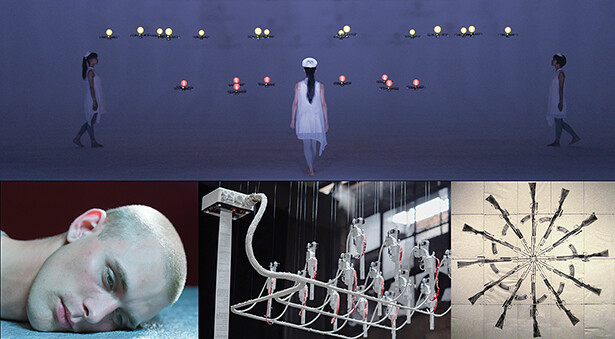Closes January 28, 2017
Prichard Art Gallery
414 S. Main Street
Moscow, ID 83843
T 208 885 3586
Timed to open just prior to Election Day and close after the impending Inauguration Day, Real & Implied gathers the work of four artists to circle around ideas of technology, remote and immediate violence and the war on terror.
It is no wonder we are enamored with drones. Their ability to instantaneously move through the air in any direction defines exactly how we wish we could move through space. Combined with a camera they are akin to a real-world video game. Like a dancer moved by an invisible hand they lift, glide and circulate effortlessly. The use of drones has exploded across all manner of application and recreation. Not surprisingly, their potential for artistic expression has also arisen. ELEVENPLAY x Rhizomatiks Research in 24 Drones creates interplay between human and mechanical bodies that is evocative and mesmerizing. They move gracefully in a symbiotic relationship with only a subtle hint of danger. This comes from the movement, at first distant then closer, but more so from an underlying fear of whirling blades near unprotected flesh.
It is current vogue to speak of “weaponzing” something. Weaponizing speech, weaponizing the internet, weaponizing social media as a means to carry out a programmatic attack. Weaponizing drones pre-dates our current fascination, but has been deployed to great effect over the past years. It harnesses our ever-expanding use of technologies with our hesitancy to place soldiers in harms way in the global war on terror. Given the dispersal and secretive operations of the networks, intelligence gathering and remote unmanned aerial vehicles seem far less costly than boots on the ground. Someone operates them in a bunker or trailer 1000s of miles away. The operators proficiency and training are defined more in terms of video game skills than battlefield training. The target is a mere apparition on a screen. Jonathan Moore and Fabio Piparo’s Artificial Killing Machine relies on information posted to internet sites that monitor US international drone strikes to drive its operation. You can sit (under the gun) and read through the reports printed out for all known attacks in the ongoing war on terror.
The distance between an object and its visual presentation is at the heart of Rosemarie Fiore’s “Gunflake Series.” They were made during a residency shortly after 9/11. A New York City native, Fiore wanted to express her anger at what had happened and trepidation as we prepared to invade Afghanistan and then Iraq. The rubbings on incredibly delicate tissue paper capture this duality. The playful flake patterns and blizzard effect, as she calls it, speak to the ubiquity of American gun culture and the simplicity to which we reach to guns and violence to solve our problems, whether personal, domestic or global.
To bring us back to the human cost of our easy trigger finger, Suzanne Opton creates photographs on the cusp of documentary work. Her Soldier Series images were made in collaboration with soldiers about to deploy for their 2nd or 3rd tour of Iraq or Afghanistan capture the emotional weight and personal sacrifice of the citizens we call upon to carryout the human side of the war on terror. We have professionalized, segmented and marginalized the military while glossing over their sacrifice with anthems of patriotism.
Through the selection and sequence of the artists, Real & Implied seeks to question our easy reliance on aggression as a path to conflict resolution. It is neither pro-gun nor anti-gun. It is neither pro-war nor anti-war. The exhibit hopes to illicit responses that add dimension to the consequences and questions about our strategies and actions.
Roger H.D. Rowley, curator


